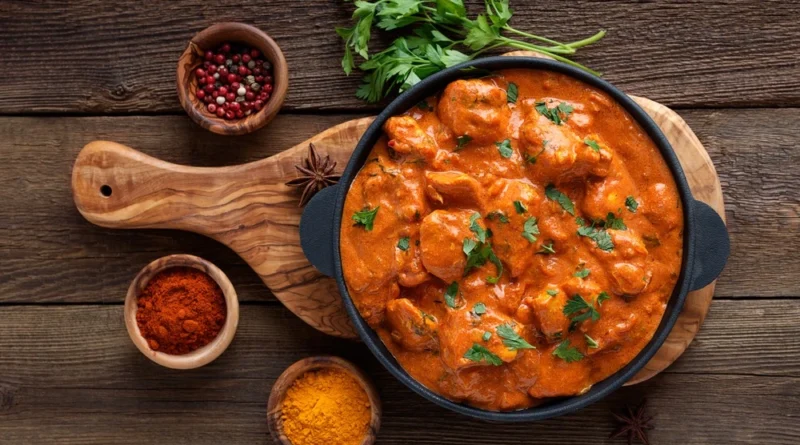The Flavorful World of Indian Curry Dishes
Indian cuisine is a vibrant and diverse tapestry of flavors, colors, and textures. At the heart of this culinary tradition lies the curry, a dish that has captured the hearts and palates of people around the globe. Whether you’re a seasoned cook or a novice in the kitchen, Indian curry dishes offer a delightful adventure in taste and aroma. In this article, we’ll explore the rich history, regional variations, and popular recipes that make Indian curry a beloved staple in kitchens worldwide.
A Brief History of Indian Curry
The term “curry” is derived from the Tamil word “kari,” meaning sauce or gravy. However, the concept of curry as we know it today is a fusion of various culinary traditions, influenced by centuries of trade, conquest, and cultural exchange. The Portuguese, who arrived in India in the 16th century, played a significant role in popularizing the dish by introducing chili peppers, which have since become a cornerstone of Indian cuisine.
Indian curry is not a monolithic dish but rather a broad category encompassing a wide range of preparations. Each region of India has its own unique take on curry, influenced by local ingredients, climate, and cultural practices. From the creamy, coconut-infused curries of the south to the rich, tomato-based gravies of the north, Indian curry dishes offer something for every palate.
Regional Variations of Indian Curry
1. North Indian Curries
North Indian curries are characterized by their rich, robust flavors and creamy textures. Dairy products such as yogurt, cream, and ghee (clarified butter) play a prominent role in these dishes. Some of the most famous North Indian curries include:
- Butter Chicken (Murgh Makhani): A creamy, tomato-based curry with tender pieces of chicken, marinated in yogurt and spices before being cooked in a tandoor (clay oven).
- Rogan Josh: A fragrant lamb curry from Kashmir, made with yogurt, aromatic spices, and a hint of saffron.
- Paneer Butter Masala: A vegetarian delight featuring paneer (Indian cottage cheese) in a rich, buttery tomato sauce.
2. South Indian Curries
South Indian curries are known for their bold flavors, liberal use of coconut, and emphasis on fresh herbs and spices. These curries often feature tamarind and curry leaves, giving them a distinctive tangy and aromatic profile. Popular South Indian curries include:
- Sambar: A lentil-based vegetable stew with a tangy tamarind broth, seasoned with mustard seeds, curry leaves, and dried red chilies.
- Fish Moilee: A Kerala specialty featuring fish cooked in a coconut milk-based sauce with turmeric, green chilies, and curry leaves.
- Chettinad Chicken: A spicy, aromatic curry from Tamil Nadu, made with a blend of roasted spices, coconut, and tomatoes.
3. East Indian Curries
East Indian curries often incorporate mustard seeds, mustard oil, and pungent spices, reflecting the region’s affinity for bold and robust flavors. Some notable East Indian curries are:
- Machher Jhol: A Bengali fish curry made with mustard oil, turmeric, and a medley of vegetables like potatoes and eggplant.
- Shukto: A Bengali mixed vegetable curry with a slightly bitter taste, often served as a palate cleanser at the beginning of a meal.
- Prawn Malai Curry: A rich and creamy curry made with prawns, coconut milk, and a blend of aromatic spices.
4. West Indian Curries
West Indian curries, particularly those from the state of Gujarat and Maharashtra, are known for their balance of sweet, sour, and spicy flavors. Key ingredients include jaggery (unrefined cane sugar), tamarind, and a variety of spices. Popular West Indian curries include:
- Vindaloo: A Goan curry with Portuguese roots, known for its fiery heat and tangy flavor, made with vinegar, garlic, and a blend of spices.
- Gujarati Kadhi: A yogurt-based curry with gram flour (besan) and tempered with mustard seeds, cumin, and curry leaves.
- Prawns Kalwan: A coastal Maharashtrian dish featuring prawns cooked in a coconut-based gravy with kokum (a sour fruit) and spices.
Essential Ingredients in Indian Curry
Indian curry dishes rely on a diverse array of ingredients to create their complex flavors. Some of the essential ingredients you’ll find in most Indian kitchens include:
- Spices: Cumin, coriander, turmeric, mustard seeds, fennel, fenugreek, and garam masala (a blend of ground spices) are staples in Indian cooking.
- Herbs: Fresh cilantro (coriander), mint, curry leaves, and fenugreek leaves add freshness and depth to curries.
- Aromatics: Onions, garlic, and ginger form the base of many Indian curries, providing a robust foundation for the flavors to build upon.
- Dairy: Yogurt, cream, and ghee are commonly used in North Indian curries to add richness and balance the heat of the spices.
- Coconut: Both coconut milk and grated coconut are extensively used in South Indian curries for their creamy texture and subtle sweetness.
- Tomatoes: Fresh tomatoes or tomato puree are often used to create a tangy base for many curries.
- Legumes: Lentils, chickpeas, and kidney beans are frequently used in vegetarian curries, adding protein and texture.
Popular Indian Curry Recipes
Butter Chicken (Murgh Makhani)
Ingredients:
- 500g chicken, cut into bite-sized pieces
- 1 cup yogurt
- 2 tbsp lemon juice
- 1 tsp turmeric powder
- 2 tsp garam masala
- 1 tsp cumin powder
- 1 tsp coriander powder
- 1 tsp red chili powder
- 2 tbsp butter
- 1 cup tomato puree
- 1/2 cup cream
- 1 tbsp ginger-garlic paste
- Salt to taste
- Fresh cilantro for garnish
Instructions:
- Marinate the chicken with yogurt, lemon juice, turmeric, garam masala, cumin, coriander, and red chili powder. Let it sit for at least 1 hour.
- Heat butter in a pan and sauté the ginger-garlic paste until fragrant.
- Add the marinated chicken and cook until the chicken is browned.
- Pour in the tomato puree and cook for 10-15 minutes until the chicken is cooked through.
- Stir in the cream, season with salt, and let it simmer for another 5 minutes.
- Garnish with fresh cilantro and serve hot with naan or rice.
Sambar
Ingredients:
- 1 cup toor dal (split pigeon peas)
- 1/2 cup mixed vegetables (carrot, potato, eggplant, drumstick)
- 1 small tomato, chopped
- 1 small onion, chopped
- 2 tbsp sambar powder
- 1 tsp turmeric powder
- 1 tsp mustard seeds
- 1 tsp cumin seeds
- 2 dried red chilies
- 1 sprig curry leaves
- 2 tbsp tamarind paste
- Salt to taste
- Fresh cilantro for garnish
Instructions:
- Cook the toor dal in a pressure cooker with turmeric powder until soft and mushy.
- In a separate pot, cook the mixed vegetables until tender.
- Add the cooked dal, vegetables, chopped tomato, and onion to a pot. Stir in the sambar powder and tamarind paste.
- In a small pan, heat oil and add mustard seeds, cumin seeds, dried red chilies, and curry leaves. Once they splutter, pour this tempering over the sambar.
- Season with salt and simmer for 10 minutes.
- Garnish with fresh cilantro and serve hot with rice or idli.
Health Benefits of Indian Curry
Indian curry dishes are not only delicious but also offer several health benefits due to the use of a variety of spices and fresh ingredients. Here are some of the health benefits associated with common ingredients in Indian curry:
- Turmeric: Known for its anti-inflammatory and antioxidant properties, turmeric is beneficial for joint health and overall immune function.
- Ginger: Helps with digestion, reduces nausea, and has anti-inflammatory effects.
- Garlic: Known for its immune-boosting properties and ability to reduce blood pressure and cholesterol levels.
- Coriander: Rich in dietary fiber, vitamins, and minerals, coriander aids in digestion and helps detoxify the body.
- Cumin: Aids in digestion, boosts the immune system, and has anti-inflammatory properties.
- Coconut Milk: Provides healthy fats that are easily metabolized by the body and contain lauric acid, which has antimicrobial properties.
Tips for Making the Perfect Indian Curry
Creating a perfect Indian curry requires attention to detail and an understanding of the interplay between various ingredients. Here are some tips to help you master the art of curry making:
- Fresh Spices: Always use fresh spices for the best flavor. Toasting whole spices before grinding them enhances their aroma and taste.
- Balance Flavors: Achieve a balance of sweet, sour, salty, and spicy flavors. Use ingredients like tamarind, jaggery, and yogurt to create depth and complexity.
- Cook Onions Slowly: Onions form the base of many curries. Cook them slowly until golden brown to bring out their natural sweetness.
- Layer Flavors: Add spices at different stages of cooking to build layers of flavor. Start with whole spices, then add ground spices, and finally finish with fresh herbs.
- Simmer Gently: Allow the curry to simmer gently to let the flavors meld together. Avoid boiling, as it can cause the dairy ingredients to curdle.
- Rest Time: Let the curry rest for a while before serving. This allows the flavors to develop and intensify.
Conclusion
Indian curry dishes are a celebration of flavors, textures, and culinary traditions. From the rich and creamy curries of the north to the bold and tangy curries of the south, each region offers a unique and delightful culinary experience. By understanding the essential ingredients, regional variations, and health benefits, you can bring the magic of Indian curry into your kitchen and enjoy a world of taste and aroma. Whether you’re making a classic Butter Chicken or a tangy Sambar, the key to a perfect curry lies in balancing the flavors and savoring the process of cooking. So, roll up your sleeves, gather your spices, and embark on a culinary journey through the vibrant world of Indian curry.

